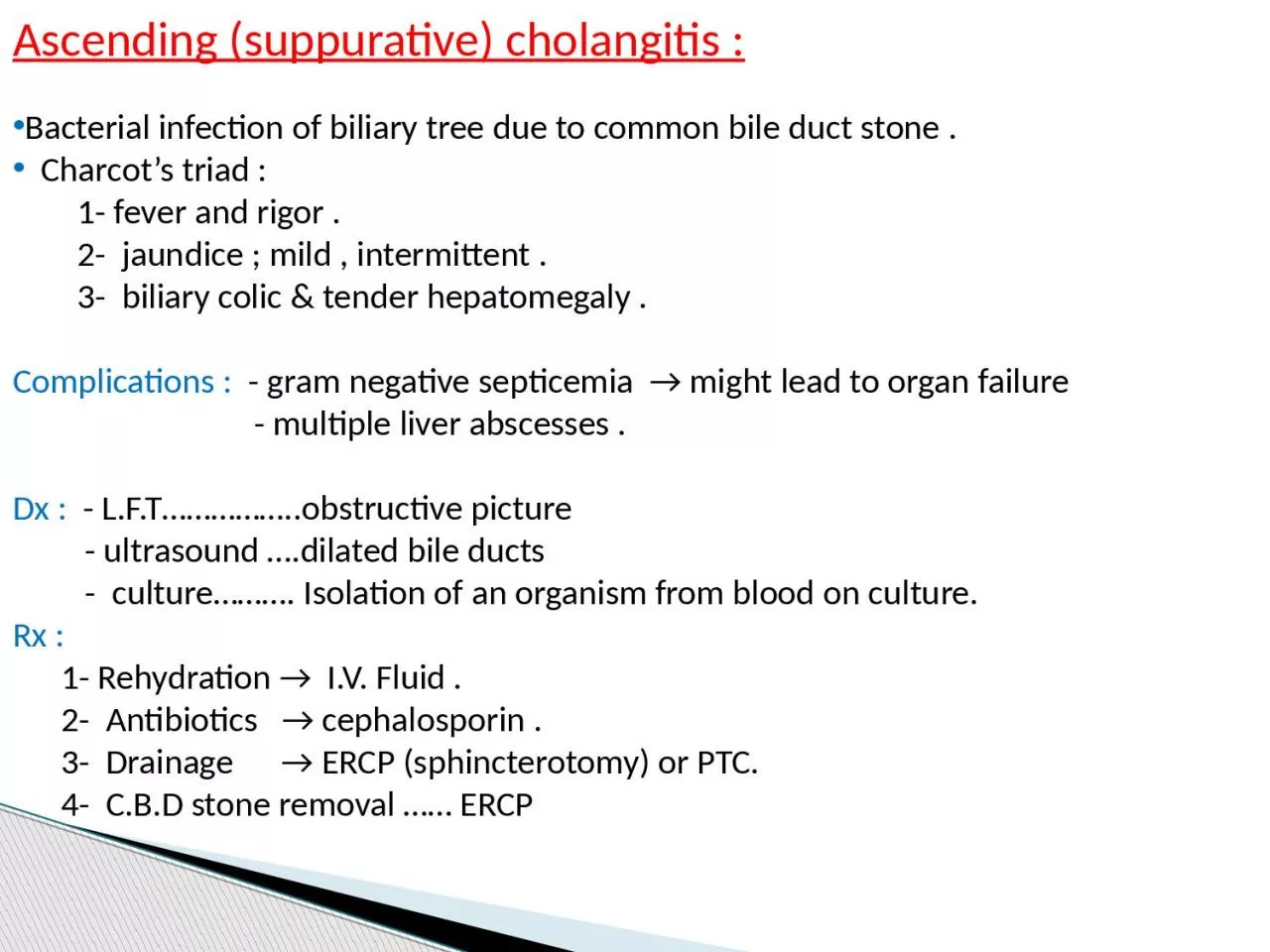

Bacterial infection of biliary tree due to common bile duct stone Charcots triad 1 fever and rigor 2 jaundice mild intermittent 3 biliary colic amp tender hepatomegaly ID: 1047093
Download Presentation The PPT/PDF document "Ascending (suppurative) cholangitis :" is the property of its rightful owner. Permission is granted to download and print the materials on this web site for personal, non-commercial use only, and to display it on your personal computer provided you do not modify the materials and that you retain all copyright notices contained in the materials. By downloading content from our website, you accept the terms of this agreement.
1. Ascending (suppurative) cholangitis : Bacterial infection of biliary tree due to common bile duct stone . Charcot’s triad : 1- fever and rigor . 2- jaundice ; mild , intermittent . 3- biliary colic & tender hepatomegaly .Complications : - gram negative septicemia → might lead to organ failure - multiple liver abscesses . Dx : - L.F.T……………..obstructive picture - ultrasound ….dilated bile ducts - culture………. Isolation of an organism from blood on culture.Rx : 1- Rehydration → I.V. Fluid . 2- Antibiotics → cephalosporin . 3- Drainage → ERCP (sphincterotomy) or PTC. 4- C.B.D stone removal …… ERCP
2. Dx : - US and CT scan → multiloculated cystic mass lesion - X-Ray → might be beneficial…..air/ fluid levelRx :Antibiotics e.g. Aminoglycoside , cephalosporin plus Drainage →Ultrasound-guided aspiration. or Lapratomy for drainage ( It might be ) .Microorganisms : - E coli , Streptococcus milleri (commonly) . - Streptococcus faecalis, Klebsiella , Proteus and StaphylococciSources of abscess of liver could be via:1- Bile duct – ascending – ( commonest ). 2- portal vein . 3-peri-hepatic infective focus4- Haematogenous (e.g.: hepatic artery) .
3. Pyogenic liver abscess : Single ( large ) or multiple ( small ) . Acute or chronic .Manifestation :Fever & lethargy , malaise . RUQ discomfort & ? pain. Anorexia . Unwell look .Patient at risk :Sickler 2) elderly 3) malnourished 4) immune suppressed 5) diabetics 6) post traumatic & post op. patients
4. Dx : - US and CT scan → multiloculated cystic mass lesion - X-Ray → might be beneficial…..air/ fluid levelRx :Antibiotics e.g. Aminoglycoside , cephalosporin plus Drainage →Ultrasound-guided aspiration. or Lapratomy for drainage ( It might be ) .Microorganisms : - E coli , Streptococcus milleri (commonly) . - Streptococcus faecalis, Klebsiella , Proteus and StaphylococciSources of abscess of liver could be via:1- Bile duct – ascending – ( commonest ). 2- portal vein . 3-peri-hepatic infective focus4- Haematogenous (e.g.: hepatic artery) .
5. Amoebic liver abscess: Tropical abscess . Dysenteric abscess . 70% solitary large abscess , 30% multiple small abscesses .M.O. : Entamoeba histolytica. dysentery → liver → localized liquefaction → abscess .Course (out come) of the disease :1- Amoebic hepatitis .2- Amoebic abscess → chocolate pus (Anchovy paste)3- encapsulated → dormant .4- Burst to : → lung and plueral cavity . → peritoneal cavity . → hollow organs . → skin .Clinical features :Aneamia 2) weight loss 3) pyrexia and night sweating 4) Pain in liver area and enlarged tender liver .
6. Dx : - US and CT scan → multiloculated cystic mass lesion - X-Ray → might be beneficial…..air/ fluid levelRx :Antibiotics e.g. Aminoglycoside , cephalosporin plus Drainage →Ultrasound-guided aspiration. or Lapratomy for drainage ( It might be ) .Microorganisms : - E coli , Streptococcus milleri (commonly) . - Streptococcus faecalis, Klebsiella , Proteus and StaphylococciSources of abscess of liver could be via:1- Bile duct – ascending – ( commonest ). 2- portal vein . 3-peri-hepatic infective focus4- Haematogenous (e.g.: hepatic artery) .
7. Dx : US. & CT. & X ray ; →CXR. → abdomen. - Isolation of organism from the stool+? from liver lesion (difficult from abscess because it is in periphery) -chocolate pusRx :Metronidazole 750 mg tds. for 7 – 10 days (mainly).Aspiration under U/S. guidance (possible)Laparoscopic or open drainage (might be needed).Indication for drainage :No response to metronidazole after 5 days .Too big size.Bacterial supper added infection .
8. Liver cysts ; → simple → hydatid (the commonest in the middle east)Simple liver cyst :Coincidal finding; Regular , thin wall , unilocular Homogenous. No surrounding tissue response and no variation in density within the cyst cavity.CT: Sharply defined margin Has no measurable wallNO Septations Calcification Enhancement Mural nodulesRx :1) No Rx if it is asymptomatic 2) Aspiration under U/S guidance ……? Possibility of recurrence. 3) Definitive Rx for large symptomatic → open or laparoscopic deroofing .
9. Polycystic liver disease:Congenital . Multiple . Associated with polycystic formation in kidneys . Often asymptomatic/ coincidental finding. Discomfort .Some time (severe pain) due to hemorrhage into a cyst →U/S or CT scanRx : - Analgesia …if no response then - open or laparoscopic fenestration of the liver cysts.